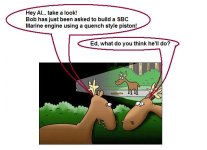kindafishy
New member
hello, all! long time lurker, first time poster
i need help. my boat is a 1996 bayliner cierra express 2452 with a mercruiser 5.7 260 hp with a closed cooling system and a bravo 2. its a big heavy cabin cruiser and i think that's part of my problem, i think its a bit underpowered making the engine work harder than it should. lost the engine 3 years ago and had it rebuilt by a reputable local machine shop. since then i've only put 150 hours on it. last time out it started making the same noise i heard the first time it broke, kinda a loud ping. shut it down right away, opened the engine cover only to see several qt's of oil in the bilge. after a quick look i can see it was being pushed out the dipstick tube. exactly what happened last time. haven't taken it apart yet but i'd bet money that the pistons are cracked again.
so i'm thinking a bit more power would be in order so i'm thinking 383. i saw a couple of threads and it seemed like "bondo" and "ricardo marine" knew their stuff. what i'm looking for is advice on what parts, or kit to use, and why?assuming my block is good whats next? i'd like to run 87 octane, and be dependable above all.
what rotating assembly?
what rod length?
which piston? what dish? forged or hyper, or other?
which cam? full roller?
which valves and springs?
rockers?
what headwork/ valve job needs to be done?
will my edelbrock 1409 still work?
anything i missed?
i'm sure someone sells a kit with a marine cruiser application specific, i just cant find it. and everyone seems to have different opinions on the subject, sort of a ford vs. chevy argument.
THANK YOU IN ADVANCE!!!
i need help. my boat is a 1996 bayliner cierra express 2452 with a mercruiser 5.7 260 hp with a closed cooling system and a bravo 2. its a big heavy cabin cruiser and i think that's part of my problem, i think its a bit underpowered making the engine work harder than it should. lost the engine 3 years ago and had it rebuilt by a reputable local machine shop. since then i've only put 150 hours on it. last time out it started making the same noise i heard the first time it broke, kinda a loud ping. shut it down right away, opened the engine cover only to see several qt's of oil in the bilge. after a quick look i can see it was being pushed out the dipstick tube. exactly what happened last time. haven't taken it apart yet but i'd bet money that the pistons are cracked again.
so i'm thinking a bit more power would be in order so i'm thinking 383. i saw a couple of threads and it seemed like "bondo" and "ricardo marine" knew their stuff. what i'm looking for is advice on what parts, or kit to use, and why?assuming my block is good whats next? i'd like to run 87 octane, and be dependable above all.
what rotating assembly?
what rod length?
which piston? what dish? forged or hyper, or other?
which cam? full roller?
which valves and springs?
rockers?
what headwork/ valve job needs to be done?
will my edelbrock 1409 still work?
anything i missed?
i'm sure someone sells a kit with a marine cruiser application specific, i just cant find it. and everyone seems to have different opinions on the subject, sort of a ford vs. chevy argument.
THANK YOU IN ADVANCE!!!
Last edited:



